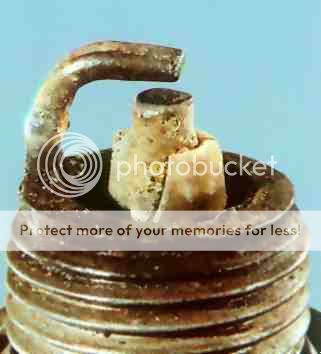Van's Air Force
You are using an out of date browser. It may not display this or other websites correctly.
You should upgrade or use an alternative browser.
You should upgrade or use an alternative browser.
Detonation
- Thread starter acam37
- Start date
Russ McCutcheon
Well Known Member
No.
No not detonation. It's from ingesting something other then air or fuel (FOD) a rivet or screw maybe.
No not detonation. It's from ingesting something other then air or fuel (FOD) a rivet or screw maybe.
DanBaier
Well Known Member
No not detonation. It's from ingesting something other then air or fuel (FOD) a rivet or screw maybe.
Probably that - what does the inside of the head look like?
Dan
BillL
Well Known Member
No not detonation. It's from ingesting something other then air or fuel (FOD) a rivet or screw maybe.
Yep, FOD, Foreign Object Damage. I am very surprised it stayed in the that long though. Count the bangs over a small area then calculate the piston and count the strokes. That was lot of stokes before spitting it out. With so many sharp edges it looks like it was steel, not aluminum.
Detonation looks more like erosion of the surface sort of like severe sand blasting.
The head will look the same. You didn't lose a ground tang on a spark plug did you? I might be concerned about stress risers in the head, but have no specific experience with this on flight engines.
acam37
Well Known Member
FOD does make more sense as the other ones were fine. I sent the cylinders off for overhaul but didn't notice any of them beat up. The #4 had a bad exhaust valve and guide, and also the exhaust port was cracked. I never flew behind the engine. I bought the plane as a project. It was cranked and run up to be sure the engine ran, maybe 5 min. total run time. According to the amount of carbon build up on top of the piston, this was not a recent event. Is there any danger of putting this piston back in service?
Mike S
Senior Curmudgeon
While I originally thought of FOD also, I am surprised to see the damage almost uniform across the entire piston.
FOD damage is usually confined to the area of the squish band, at least from my personal experience.
I would hazard a guess that this may be due to someone chipping off the hardened carbon in a prior rebuild.
Do you know the history of this engine?? Any prior rebuild or top overhaul?
FOD damage is usually confined to the area of the squish band, at least from my personal experience.
I would hazard a guess that this may be due to someone chipping off the hardened carbon in a prior rebuild.
Do you know the history of this engine?? Any prior rebuild or top overhaul?
acam37
Well Known Member
Mike, this baffled me also so I called the guy who has my cylinders and he told me none are beat up like the piston. As for engine history, the only thing in the log book was an entry back in 1991 that documented a major overhaul. The Hobbs on the plane was at 410hrs total time. The engine was installed when the plane was built in '91. It set up for many years, thus ruining the cam, lifters, and accessory gears. I know this damage couldn't have happened when I test ran the engine. Too much old carbon build up on top. The funny thing is that during the pre buy, I cranked the engine to check oil pressure and mags, pulled the plugs, checked compressions, and did a visual on the oil. All looked good on the surface. I'm just glad I discovered these problems on the ground rather than at 100ft on takeoff.
Mike S
Senior Curmudgeon
Does the 1991 entry for an overhaul state if new pistons were installed?
From what I have seen of detonation, it caused pretty sever damage, with a cratering appearance, not sharp edged damage/divots like in your photo. And often only in certain areas, not evenly spread all over the entire crown.
It looks like you used a wire wheel to clean off the piston, and that may have altered the look of the damage.
Just my best guess here, this is kinda puzzling.
Please report back if you find the cause.
From what I have seen of detonation, it caused pretty sever damage, with a cratering appearance, not sharp edged damage/divots like in your photo. And often only in certain areas, not evenly spread all over the entire crown.
It looks like you used a wire wheel to clean off the piston, and that may have altered the look of the damage.
Just my best guess here, this is kinda puzzling.
Please report back if you find the cause.
Omega232Devils
Well Known Member
BillL
Well Known Member
Now -THIS looks more like typical FOD, the piece gets ejected or sticks in something and makes noise. It makes one wonder if several spark plugs had trouble from preignition or damage in this same bore, or shed several pieces. What plugs were being used? Odd, but just replace it, inspect for other damage and proceed.
Last edited:
F1Boss
Well Known Member
Forged pistons available here:
http://combustech.com/Products/Lycoming Pisons/ASC75089F.html
Other compression ratios available too.
Carry on!
Mark
http://combustech.com/Products/Lycoming Pisons/ASC75089F.html
Other compression ratios available too.
Carry on!
Mark
PISTONS
D'ont try to poor boy an over haul I woud replace pistons ex. vales probally guides I often buy new cyls from airpower also rod bolts ,nuts and fasteners required on o/h ,cases should be rebuild along with many other items . You will get back what you put in ,also wire wheeling and beed blasting pistons turns them into junk
D'ont try to poor boy an over haul I woud replace pistons ex. vales probally guides I often buy new cyls from airpower also rod bolts ,nuts and fasteners required on o/h ,cases should be rebuild along with many other items . You will get back what you put in ,also wire wheeling and beed blasting pistons turns them into junk
acam37
Well Known Member
Update
I called the guy who has my cylinders and explained the piston damage to him. He said that it appeard the #1 cylinder was swapped out at one point in time. All the other jugs had numbers stamped except #1. There is nothing in the log book showing any major engine repair. After examining the piston further, I noticed the Bevel around the top was considerably narrower than the rest, suggesting the top was "dressed" to remove most of the divots. That's one more reason to take this one out of service.
Thanks guys for helping me figure this one out. I really thought this was a case of either over heating or bad Detonation. I'm glad y'all straightened me out.
I called the guy who has my cylinders and explained the piston damage to him. He said that it appeard the #1 cylinder was swapped out at one point in time. All the other jugs had numbers stamped except #1. There is nothing in the log book showing any major engine repair. After examining the piston further, I noticed the Bevel around the top was considerably narrower than the rest, suggesting the top was "dressed" to remove most of the divots. That's one more reason to take this one out of service.
Thanks guys for helping me figure this one out. I really thought this was a case of either over heating or bad Detonation. I'm glad y'all straightened me out.
Piston Damage
That is a normal appearing piston crown on a used piston. The piston is permanent mold cast, not a machined crown and that is normal. If it was detonation there would be some skirt damage and I cannot see that from the picture. I don't think you can detonate a 8.5:1 piston unless the ignition is mistimed.
However, if you are overhauling the engine, it's a good call to replace the piston (and mandatory per Lycoming Service Bulletin 240W.)
That is a normal appearing piston crown on a used piston. The piston is permanent mold cast, not a machined crown and that is normal. If it was detonation there would be some skirt damage and I cannot see that from the picture. I don't think you can detonate a 8.5:1 piston unless the ignition is mistimed.
However, if you are overhauling the engine, it's a good call to replace the piston (and mandatory per Lycoming Service Bulletin 240W.)
chazking
Well Known Member
Research
I did some inquiries and here's a response that might prove useful....
On an older engine a piece of the exhaust valve broke and caused similar damage. After cylinder / piston replacement, the condition recurred on all cylinders. The piece was "floating" around in the intake system and caused damage to the new cylinder / piston and the others as well.
The recommendation was to inspect the entire intake system as an errant object could go to the other cylinders thru the valve lap event.
I did some inquiries and here's a response that might prove useful....
On an older engine a piece of the exhaust valve broke and caused similar damage. After cylinder / piston replacement, the condition recurred on all cylinders. The piece was "floating" around in the intake system and caused damage to the new cylinder / piston and the others as well.
The recommendation was to inspect the entire intake system as an errant object could go to the other cylinders thru the valve lap event.
Upgrade
For EAB unless you have a very early narrow deck engine the upgrade to 160 hp is just pistons and piston pins.
For type certificated aircraft with plain steel cylinders the cylinders must be nitride or plated(chrome etc) for 160 hp upgrade.
I'm by no mean an expert, not even close but I've read in many documents and have heard by several sources that "upgrading" is not just as simple as new pistons. Lots of other things to consider. I'll let the experts chime in with more details.
For EAB unless you have a very early narrow deck engine the upgrade to 160 hp is just pistons and piston pins.
For type certificated aircraft with plain steel cylinders the cylinders must be nitride or plated(chrome etc) for 160 hp upgrade.








